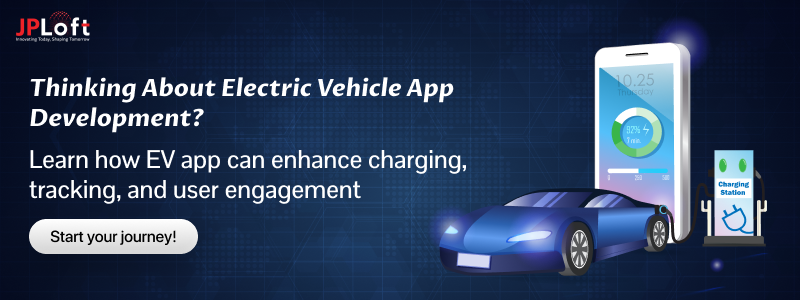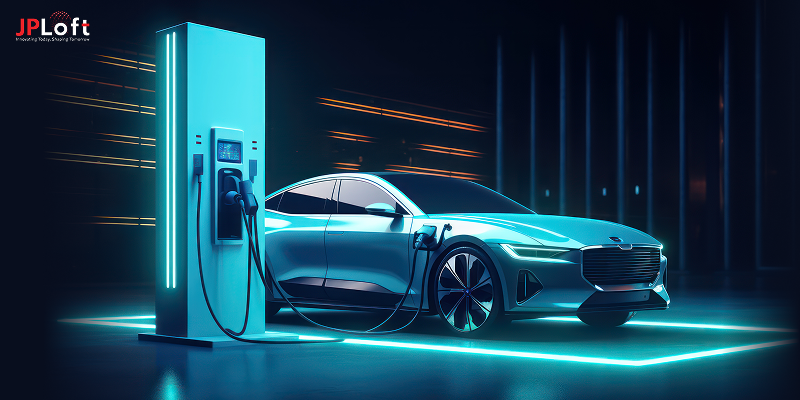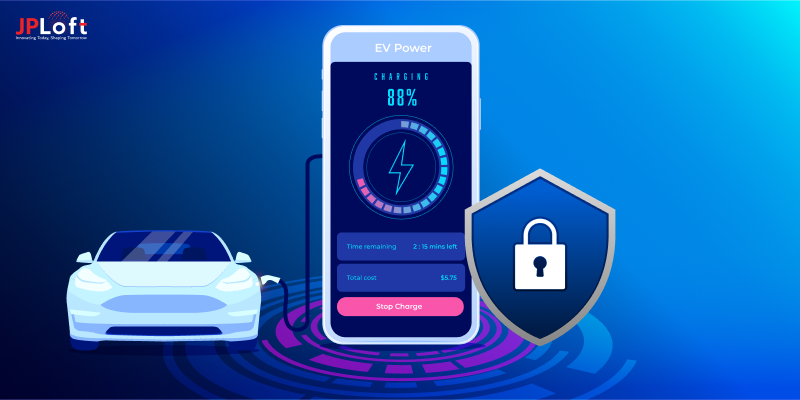Designing an EV app isn’t just about colors and buttons; it’s about creating an experience that feels effortless and smart. The secret to a successful EV app lies in its design.
But here comes the main question “how to design an EV app that merges clean UI with smart functionality?” The secret lies guiding users effortlessly with intuitive navigation, real-time data, and smart features like EV charging and tracking.
With the global EV app market projected to surpass $200 billion by 2030, creating a seamless app experience is more important than ever.
So, in this blog, we’ll take you through a step-by-step guide to EV app design that turns ideas into an engaging, future-ready app.
Overview of Electric Vehicle App Design
Designing a successful electric vehicle app requires more than just coding skills, it’s about combining intuitive design, smart functionality, and seamless user experience. But what exactly does EV app design mean?
In essence, it’s the process of creating a digital interface that allows users to interact effortlessly with their electric vehicles, from locating charging stations to monitoring battery health and planning efficient routes.
Features like real-time EV tracking, charging station locations, route planning, and energy consumption analytics are essential, and collaborating with experts offering UI/UX design services ensures these functionalities are delivered in an intuitive and user-friendly way.
A clean and intuitive interface ensures that users can navigate the app effortlessly, while smart integrations like push notifications, reminders, and predictive insights enhance engagement. Another key aspect of electric vehicle software development is scalability.
As EV technology evolves, apps must adapt to new vehicles, charging infrastructure, and connected mobility solutions. This makes forward-thinking design and modular architecture essential for a future-ready app.
When planning your app, follow tips for designing an EV app: focus on simplicity, maintain a consistent UI/UX, prioritize essential features, and ensure smooth interaction between software and vehicle data.
Incorporating analytics and user feedback helps refine the app continuously, ensuring it remains relevant and user-friendly. In essence, electric vehicle app design is a delicate balance between functionality, aesthetics, and technology.
By following a structured design process and keeping the user at the center, developers can create an app that not only supports electric mobility but also provides a delightful, intuitive experience for EV users.
Electric Vehicle App Design Components
When it comes to electric vehicle app design, the key is blending functionality with a smooth, intuitive experience. Imagine a user opening your app for the first time, they should instantly feel in control of their EV journey.
The EV app interface design plays a huge role here, turning complex vehicle data into simple, actionable insights. Let’s explore the core components that make a great EV app:
-
Clean and Intuitive Dashboard: The first thing users see should give them an overview of battery status, charging points, and trip stats. A well-thought-out EV app UI design ensures this information is accessible without clutter.
-
Charging Station Locator: Users want real-time access to nearby charging points. Integrating maps, distance, and availability updates makes the app truly practical.
-
Route Planning and Navigation: Smart routing with energy-efficient paths is a must. Incorporating predictive analytics can help users avoid running low on charge during trips.
-
Vehicle Monitoring & Analytics: From speed to energy consumption, users appreciate transparent insights. Interactive charts and notifications make this data engaging.
-
Smart Notifications & Reminders: Alerts for low battery, maintenance, or nearby chargers keep users connected to their EV, enhancing the overall experience.
-
User Profile & Personalization: Allow users to customize themes, preferred routes, and notifications. Personal touches make the app feel tailored to their journey.
-
Innovative Features & Future Ideas: Thinking beyond basics, integrating features like Electric Vehicle app ideas for gamification, social sharing, or eco-driving tips can create a unique edge.
By focusing on these components, your EV app interface design becomes more than just an app, it becomes a companion for every electric journey. Combining aesthetics with smart functionality ensures that the app is not only visually appealing but also indispensable for EV users.
Why Do You Need an Attractive EV UI/UX Design?
When it comes to how to design an EV app, one of the most critical aspects is creating an attractive UI/UX. Users may forgive minor bugs, but a confusing or cluttered interface can drive them away instantly.
A well-designed interface not only improves usability but also builds trust, encourages engagement, and enhances overall satisfaction.
Starting with processes like app wireframing and app prototyping during the design process ensures that the layout, navigation, and features are tested and refined before development, creating a smoother experience for users.
Here’s a quick overview of the impact of an attractive UI/UX Design of EV apps:
|
UI/UX Component |
Impact on Users |
|
Clean & Intuitive Layout |
Users can navigate the app effortlessly without confusion, reducing frustration, mistakes, and app abandonment. |
|
Interactive Dashboard |
Provides quick access to critical information like battery status, charging stations, and route planning, making the EV experience seamless. |
|
Personalized Experience |
Tailoring features, themes, and notifications to each user keeps them engaged, encourages frequent use, and builds loyalty. |
|
Security & Privacy Features |
Integrating secure login, encrypted data, and privacy measures ensures users feel confident their personal and vehicle information is protected. |
|
Real-Time Notifications |
Timely alerts about charging, battery levels, and nearby stations help users take immediate actions, improving convenience and overall satisfaction. |
|
Smooth Performance & Speed |
Fast load times and responsive screens prevent frustration and make interactions enjoyable, giving users a sense of reliability. |
|
Visual Hierarchy & Design |
Clear fonts, colors, and icons guide users intuitively through the app, reducing cognitive load and making features easy to understand. |
In short, focusing on an attractive EV UI/UX design isn’t just about looks, it’s about creating a practical, engaging, and secure experience.
Whether you aim to start a mobile EV charging business or scale your EV app, prioritizing UI/UX is a step toward success.How to Design an Electric Vehicle App?
Designing an EV app isn’t just about creating a digital tool, it’s about building a connected experience for the next generation of mobility. If you’ve ever wondered how to design an EV app that users love, this is your complete guide.
From concept to deployment, every step of the electric vehicle app design journey shapes how drivers interact with their vehicles, manage charging, and connect to the world of smart mobility.
Let’s explore the complete guide to Electric Vehicle app design from idea to implementation, so you can design your electric vehicle app with confidence and creativity.
Step 1: Start with Research and User Understanding
Before diving into the UI/UX Design of EV apps, start with empathy. Understand your target audience, their needs, preferences, and frustrations.
Are you designing for EV owners, fleet managers, or charging station operators? Each user group expects something different.
Market research also helps you identify EV app development trends, popular app features, and gaps in existing solutions. For instance, many users want real-time charger availability, while others look for smart routing or payment integrations.
Study your competitors’ apps, read customer reviews, and collect insights that help refine your design vision.
Step 2: Plan the App’s Core Features and Flow
Once you understand your audience, it’s time to define what your app will actually do. The secret to smart Electric Vehicle app design is simplicity, offering features that matter most.
Start with essential Electric Vehicle app features to help users with live availability, pricing, and directions. Don’t forget smart notifications for reminders, tips, or updates, and secure login with payment systems following app security.
When planning the design of your Electric Vehicle app, focus on the basics first, build an MVP, gather feedback, and evolve from there. Every successful EV app starts with a clear flow and purposeful features.
Step 3: Focus on UI/UX – The Heart of EV App Design
Now comes the most exciting part, the UI/UX design of the electric vehicle app. This is where your concept comes to life visually. A great EV app interface design should feel futuristic yet familiar, something users can navigate effortlessly from the very first tap.
Focus on simplicity and connection. Keep the interface clean, typography modern, and color palette aligned with your brand’s eco-friendly identity. Consistency across buttons, icons, and layouts creates trust, while accessibility ensures users of all ages can engage comfortably.
Subtle motion and micro-interactions can make your app feel alive, while offering dark and light modes adds comfort for users who often drive at night.
Step 4: Integrate Smart Features and Technologies
Once your design foundation is set, it’s time to give your app a brain. The future of app development lies in merging design with intelligence through technologies like IoT, AI, and cloud integration.
Imagine your app syncing directly with the vehicle through IoT connectivity, pulling real-time data such as battery status, range, or tire pressure. Add AI-driven suggestions that recommend the best charging times, routes, or driving modes.
With cloud-based storage, you can securely save user preferences and trip histories, while predictive maintenance alerts keep users informed before an issue ever occurs. By blending thoughtful design with smart technology, your electric vehicle app design evolves beyond a digital tool.
Step 5: Ensure Security, Testing, and Performance
Security is non-negotiable. Following EV app security best practices ensures users’ data stays safe, especially during payments and data syncing. Use encryption, authentication layers, and secure cloud servers to protect sensitive information.
Then comes testing, one of the most critical steps of designing an EV app. Test for UI responsiveness, speed, performance, and cross-platform compatibility. Remember, your goal is to design an EV app for Android & iOS users alike, ensuring the same flawless experience across devices.
Test your app in real-world conditions, different devices, charging stations, and network speeds to guarantee reliability.
Step 6: Development and Launch
Once your EV app design is finalized and thoroughly tested, don’t overlook the final step that is deployment.
You’ll need to submit an iOS app to App Store and publish app to Google Play Store to make it accessible to users worldwide. Each phase, from design and development to testing and launch, requires careful planning and attention to detail.
Rushing through these steps can risk performance and user satisfaction, so focus on precision and quality at every stage.
Step 7: Launch, Gather Feedback & Improve
After the launch, your journey doesn’t end, it evolves. Gather user feedback, monitor analytics, ensure app maintenance service and track how people interact with your app.
Look at metrics like session duration, active users, and feature usage to identify what works and what needs improvement. Constant updates, design refinements, and feature additions based on user insights help your electric vehicle app design stay fresh and competitive.
Innovative app design ideas such as gamification (rewarding eco-driving), AR-based navigation, or smart home charging integration to keep users engaged.
Designing an EV app is a journey of innovation, empathy, and precision. Whether you aim to develop EV fleet management apps, or craft something entirely new, it all starts with great design.
By following this complete guide, you’re not just learning how to design an electric vehicle app, you’re shaping the future of smart, sustainable mobility. So take your first step today and design your app that truly drives the change.
How Much Does It Cost to Design an EV App?
When it comes to how to design an Electric Vehicle app, one of the biggest questions that businesses ask is,“How much will it cost?” The truth is, there’s no one-size-fits-all answer.
The cost to build an EV software depends on factors like design complexity, number of features, target platforms (Android, iOS, or both), and the development partner you choose. Estimated total cost can be between $20,000 and $60,000+, depending on project scope, region, and development expertise.
If you aim for a sleek EV app design with advanced features like IoT connectivity, predictive analytics, and AI-driven recommendations, the cost naturally scales up.
On the other hand, a simple MVP (Minimum Viable Product) focused on the basics such as charging station locators and battery health tracking will cost considerably less.
Here’s a quick breakdown of what you can expect:
|
EV App Design & Development Stage |
Description |
Estimated Cost (USD) |
|
UI/UX Design of Electric Vehicle App |
Wireframing, user flow, prototyping, and interface design. |
$4,000 – $8,000 |
|
Core Features & Functionality |
Charging locator, trip planner, fleet management, and smart notifications. |
$8,000 – $15,000 |
|
Advanced Integrations |
AI, IoT, cloud storage, and predictive maintenance. |
$10,000 – $20,000 |
|
Cross-Platform Development |
Design an EV app for Android & iOS simultaneously for wider reach. |
$12,000 – $18,000 |
|
Testing & QA |
Usability testing, performance checks, and bug fixing. |
$2,000 – $5,000 |
|
Deployment & Launch |
To submit apps to the App Store and publish apps to Play Store with compliance. |
$1,000 – $2,500 |
Choosing the best mobile app development company can make a world of difference in balancing quality and cost. Remember, investing in thoughtful design and seamless functionality upfront pays off in long-term success.
After all, a well-built EV app isn’t just software, it’s the digital bridge between users and the future of sustainable driving.
Top EV Apps with Impressive UI/UX Designs
If you’re researching how to design an EV app that users genuinely love, one of the smartest ways to start is by studying the best in the business.
These top EV apps don’t just provide features, they deliver seamless, intuitive, and futuristic user experiences that make EV ownership effortless.
Let’s explore a few industry leaders that have nailed EV app design:
A] PlugShare – The Global Charging Network Hero
When it comes to the best EV apps, PlugShare stands tall. It’s trusted by millions of EV drivers worldwide for its clean interface and easy navigation.
The app’s design focuses on real-time charger availability, user-generated reviews, and simple filters that help drivers find compatible stations instantly.
If you plan to develop an app like PlugShare, take inspiration from its minimalist map layout, color-coded charger types, and clear call-to-actions.
B] ChargePoint – A Balance of Tech and Simplicity
ChargePoint combines strong backend technology with a beautifully consistent front end.
Its UI ensures drivers can start a charging session with just a tap, while the UX emphasizes clarity. from pricing details to charging speed indicators.
This app proves that when you know how to design an Electric Vehicle app, simplicity always wins over clutter.
C] Tesla App – The Future in Your Pocket
Tesla’s app perfectly aligns with the brand’s futuristic ethos. Its EV app interface design uses elegant gradients, sleek animations, and smart automation that lets users precondition their car, track charging progress, or lock/unlock remotely.
For businesses looking to push the boundaries of EV app functionality, this app serves as inspiration to build an AI agent like Tesla, enabling intelligent automation, predictive insights, and a highly personalized user experience that anticipates driver needs.
D] Electrify America – Clean, Accessible, and Insightful
Electrify America’s app delivers one of the best EV charging apps through smooth transitions and accessible layouts.
Its emphasis on journey planning, real-time pricing, and payment integration creates a sense of reliability and transparency.
Design-wise, it maintains excellent contrast, easy readability, and quick navigation, all key lessons for anyone learning how to design an Electric Vehicle app with user satisfaction at its core.
E] EVgo – Personalization Meets Performance
EVgo brings personalization to the forefront. Its dashboard-style design allows users to view charging sessions, rewards, and nearby offers at a glance.
Combined with a soothing color palette and quick-loading maps, it demonstrates that good design is about speed, simplicity, and story.
Each of these apps showcases how thoughtful EV app design shapes the user experience. Whether you want to create an app new, take note of their consistency, clarity, and emotional resonance.
Key Tips for Effective Electric Vehicle App Design
Designing an EV app that users love is all about merging creativity, clarity, and technology. If you’re exploring how to design an Electric Vehicle app that truly connects with users, here are some tried-and-tested tips to guide you:
-
Understand Your Audience: Start by identifying who your users are, city commuters, long-distance drivers, or fleet managers. Their needs will shape your EV app design, from charging station discovery to route optimization.
-
Keep the Interface Clean and Intuitive: Simplicity always wins. Use consistent icons, smooth transitions, and plenty of whitespace. A clean EV app interface design helps users focus on what matters most without distractions.
-
Prioritize Performance & Speed: Even the most stunning app loses impact if it lags. Optimize images, animations, and transitions to deliver a lightning-fast experience on both Android and iOS.
-
Focus on Functional Aesthetics: Every design element should serve a purpose, whether it’s the color palette evoking eco-friendliness or typography ensuring readability on the go. Design for the feeling of ease and innovation.
-
Test Early and Iterate Often: When planning your timeline to develop an EV app, reserve time for user testing and revisions. Gathering feedback during the prototype phase helps you refine the app before launch.
-
Collaborate with Experts: Partner with a top mobile app development company in Denver that understands both design and technical nuances. Their expertise ensures your creative ideas translate into a scalable, user-friendly app that performs seamlessly.
-
Think Beyond Launch: Great design doesn’t stop once you go live. Continuously analyze user behavior, collect insights, and update your UI/UX to keep your EV app modern, engaging, and aligned with user needs.
Designing an electric vehicle app that stands out in today’s EV ecosystem requires a perfect blend of innovation, strategy, and user understanding.
Whether you’re aiming to build a seamless charging experience or an all-in-one EV companion app, these design tips can guide you toward success.
Partner With JPLoft to Build an Engaging EV App Design
Looking to bring your EV app vision to life? JPLoft, a leading Electric Vehicle software development company, specializes in crafting innovative and user-friendly EV apps that engage users from the first tap.
Whether it’s developing smart charging solutions, fleet management dashboards, or futuristic UI/UX designs, JPLoft combines technical expertise with creative design to deliver top-notch solutions.
By partnering with us, you get access to skilled developers, intuitive designers, and a proven process that ensures your app is scalable, secure, and optimized for both Android and iOS.
From wireframing and prototyping to full-fledged app deployment, we make the journey of creating an EV app seamless and efficient.
Elevate your electric mobility solutions today with a team that understands the pulse of the EV market and transforms your ideas into a digital reality.
Final Wrap-Up
Designing a successful EV app is more than just coding, it’s about creating a connected, seamless, and enjoyable experience for users.
By following this complete guide on how to design an EV app, you can ensure your app balances functionality, aesthetics, and smart technology.
From understanding your audience and planning core features to designing intuitive UI/UX and integrating advanced technologies, every step matters. Partnering with the right team, planning your timeline, and prioritizing user engagement can transform your vision into a reliable, high-performing digital product.
Take the leap into the future of electric mobility by designing an EV app that users will love and rely on every day.
FAQs
A successful EV app combines intuitive UI, clean layouts, consistent icons, readable typography, and smooth transitions that guide users effortlessly through the app.
Focus on simplicity, accessibility, and functional aesthetics. Use clear navigation, smart color palettes, micro-interactions, and dark/light modes to enhance user experience.
The process includes understanding your audience, planning core features, wireframing, prototyping, UI/UX design, testing, and refining based on user feedback.
App prototyping and app wireframing are crucial as they allow you to visualize flows, test usability, and identify design improvements before full-scale development.
Focus on easy navigation, real-time charging info, battery monitoring, trip planning, notifications, and secure payments, all presented in a clean and visually appealing interface.













Share this blog